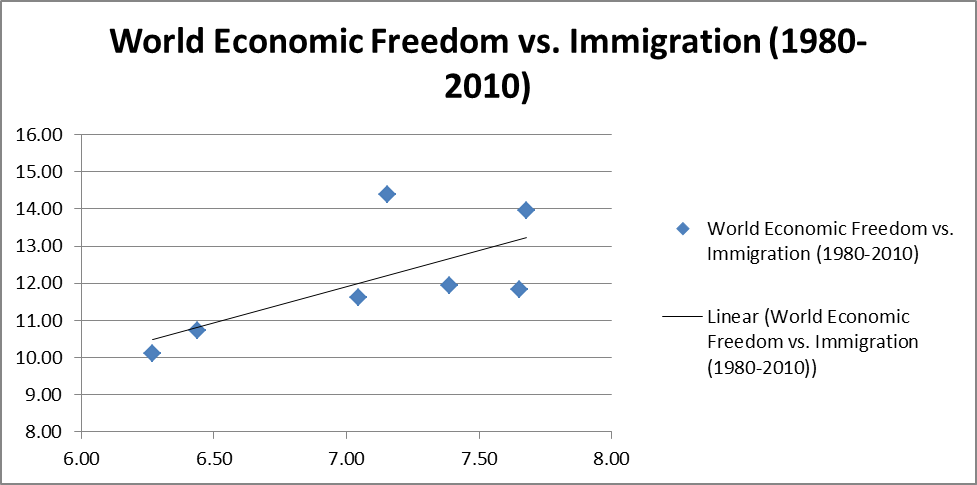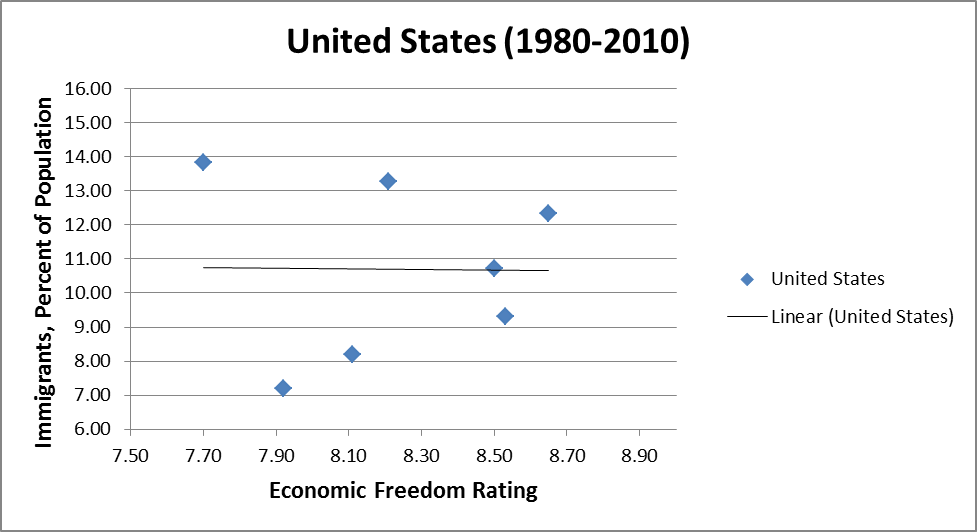This post was originally published at the Cato-at-Liberty blog and is republished with the author’s permission.
Thomas Sowell is an influential and prolific writer whose books span the social sciences. My shelves are full of them, decorated with underlines, marginalia, and dog-eared pages. But in his recent columns and comments on immigration, Sowell has not approached that topic with the same rigorous attention to detail that he has in his books. His reliance on incomplete historical examinations in his columns leads him to seemingly support a vast array of government interventions. In these writings, Sowell makes the same mistakes that he accuses the “anointed” of making in many of his books.
In the column I’ll focus on, professor Sowell’s claim that today’s debate about immigration reform is not as fact-based as previous debates. The implication is that a lack of facts will lead to poor policy decisions today whereas the policy changes 100 years ago were well thought out and fact-based. He wrote:
A hundred years ago, the immigration controversies of that era were discussed in the context of innumerable facts about particular immigrant groups. Many of those facts were published in a huge, multi-volume 1911 study by a commission headed by Senator William P. Dillingham.
First, Sowell’s description of the Dillingham Commission’s commitment to facts is inaccurate. It was a bi-partisan committee formed in 1907 to investigate the impacts of immigration on the United States – especially the so-called “new immigrants” from Eastern and Southern Europe. The Commission was staffed by Progressives who believed that scientific managerial methods could effectively plan large parts of society and the economy by using the power of the government. With the exception of one member, William S. Bennet of New York, the commission was stacked with members who had previously supported immigration restrictions.
The Dillingham Commission produced 42 volumes by 1911, arguing that the “new immigrants” were fundamentally different from old immigrants who came from Western and Northern Europe. Their culture, rates of economic success, and assimilative potential were supposedly severely constrained. Those are the same claims made by today’s immigration opponents. The Dillingham Commission suggested that immigration restrictions (ranging from relatively modest literacy tests to outright quotas and other massive interventions) could solve this “problem.”
Information gathered by the Commission that showed new immigrants succeeding and assimilating was ignored or explained away because it contrasted with the world view of the commission members. When charitable societies started to report on questionnaire slips that large numbers of Western and Northern Europeans received aid, “the slips were returned to societies for further information or for corrections.” The Commission defined retardation for children as being behind in school – an absurd definition designed to exaggerate retardation among non-English speaking immigrant children. In American schools, the Dillingham Commission found that 66.9 percent of Polish Jewish students and 63.6 percent of Southern Italians students were retarded. The Dillingham Commission was intensely worried about Asian immigration.
Today’s immigration debate is better off without these types of “facts” produced by a commission designed to reach a certain conclusion.
The Commission’s findings were similar to Sowell’s comment: “The immigrants of today are very different in many ways from those who arrived here a hundred years ago.” Literally, Sowell is correct, but the implication that they are different in ways that make them less suited to modern American society doesn’t follow. Immigration restrictionists 100 years ago said the same thing about Southern and Eastern European immigrants, looking back fondly on the Germans, Nordics, and Irish immigrants who came before. Brutal terrorist bombings carried out by Italian anarcho-communists, including 38 mail bombs in 1919 and numerous attempts on the life of Attorney General A. Mitchell Palmer, confirmed the pessimism.
Before the Dillingham Commission, immigration restrictionists in the early and mid-19th century thought the Germans and Catholic Irish were unassimilable compared to the Scots-Irish and Huguenots who came before. One worry about the Germans was that their collectivist culture and political struggles in Germany would clash with the individualism necessary to make freedom flourish in America. Catholics were considered to harbor a deep anti-republicanism and a culture inimical to liberty. Time has shown how absurd those worries were.
Thomas Sowell wrote two books explaining the flaws of supporting massive government interventions based on the recommendations of elites – especially in the face of so much historical and economic counter-evidence. In the Vision of the Anointed, Sowell rightly criticizes the Ralph Naders of the world for spinning tales of doom and gloom that call for government intervention based on very little evidence. He humorously calls these people Teflon prophets. But Sowell is acting as a Teflon prophet when it comes to immigration. In a cagey way, he predicts that great harm will come to the United States due to immigration. He does not propose a policy solution but because he describes a supposed problem with such a dire tone the reader is meant to feel that he should oppose immigration liberalization.
Did the Dillingham Commission’s fears that new immigrants and their descendants would fail to assimilate come true?
Asians and their descendants, a group viciously criticized by the Dillingham Commission, have culturally assimilated and their rate of economic success exceeds that of other Americans. You don’t have to take my word for it, just read what Thomas Sowell has written on the issue. Italians, Jews, and other immigrant groups criticized by the Commission also culturally assimilated and their descendants have been very successful. The Dillingham Commission was clearly wrong about these immigrant groups. Immigration restrictions inspired by that Commission imposed large costs on America: We likely lost an opportunity to have at least tens of millions of more productive citizens from Europe, Asian, and elsewhere – unintentionally sentencing many to death.
The Dillingham Commission also claimed that there were just too many people and the economy could not create enough wealth to sustain a high standard of living – a ludicrous proposition thoroughly demolished by Julian Simon. With a population of just over 92 million people in 1910, the Commission concluded that too much immigration was slowing America’s economic growth and that large numbers of new people were not necessary for industrialization because that phase of economic expansion was behind us … in 1910. Such grandiose claims of the future that call for government intervention could only come from the self-proclaimed anointed.
The Dillingham Commission was severely criticized when it was released and was not accepted as fact as Sowell claimed. A criticism of the report famously questioned its entire statistical methodology and conclusions. That criticism, sponsored by the American Jewish Committee, dismissed the “popular delusion” that immigrants displace American workers by writing: “[i]n the long run … supply and demand approximately balance each other.” Just as then, similar disagreements have continued to this day over other immigration studies.
The Dillingham Commission’s immigration restrictionist recommendations were based on poor statistical methods, an undue faith in the ability of Progressive social-reforms to guide social development, and a rejection of labor market economics. The Dillingham Commission was not an honest study to determine the facts of immigration as Professor Sowell described.
Second, Sowell brings up the Boston terror attack as a warning against immigration of people with cultures that are incompatible with Western values. He has a point about security, but it’s not that immigration should be curtailed. As much as this is painful to consider, some criminals and terrorists will always be able to sneak in regardless of our immigration policy. The question is not whether we want no criminals or a lot of criminals, the relevant question is: which system will prevent more criminals and terrorists from entering at an acceptable cost?
A legal system that prevented all immigration and tourism would prevent some criminals from coming in and could have prevented the Boston terror attack, but at a gargantuan economic cost not to mention the violation of individual liberties such a policy would entail. But a more open immigration system that screens people for criminality but lets peaceful people through will reduce the size of the haystack and make it easier for law and immigration enforcement to catch the criminal and terrorist needles. Public policy should be based on facts and not anecdotes. There is evidence that there should additional screenings and investigations for some immigrants but that does not mean blanket bans on the immigration of certain ethnic or religious groups should be instituted.
Thomas Sowell’s trust in the findings of a Progressive immigration commission that recommended massive government interventions based on manipulated statistics – a near textbook example of a Teflon prophet – is in blaring contrast to the rest of his work that produces many reasons to be skeptical of such schemes. In 100 years, will Americans look back fondly on today’s immigrants and their successful assimilation as they have in other periods of American history? Or will this be the first time that immigrants and their descendants don’t become Americans? Given the rapid rate of assimilation across the board, with varying rates of success, there is little to distinguish today’s immigration experience from that of our forefathers.


